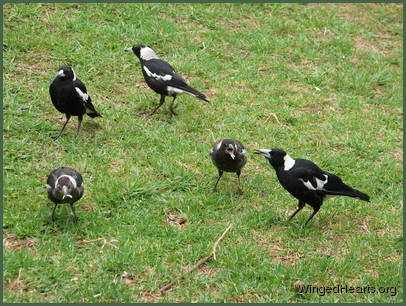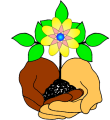Building Trust and Friendship with Wild Birds - Part 2
 Now the birds are getting used to you taking an interest in them. They are beginning to create their own patterns of understanding your words and behaviour, based on the sound and tones of your words and also your actions and movements.
Now the birds are getting used to you taking an interest in them. They are beginning to create their own patterns of understanding your words and behaviour, based on the sound and tones of your words and also your actions and movements.
In part 1 yesterday we covered - 1. Talking to the birds and 2. Watching Their Response.
Every species and every bird in every species will take their own time to respond to you. Some of the bolder birds will start coming forward giving you the opportunity to observe them at close range.
At this point there are a few different things you can start doing.
3. Identify one or a few of the Birds.
Using any of the techniques that I've explained in the 'Recognising Your Bird' series of posts you can try to identify 2-3 key features that help you recognise the birds that are beginning to respond. Remember that you don't need to know every feature, only enough to help you identify the main 2-3 birds at this stage. Start with just one bird. This may take a few days, as it takes our eyes/brain time to develop the pattern recognition ability needed for that particular species. In the picture at the top, you can see Renuthri (noisy-miner) sitting beside Dimpy (pied butcherbird).
4. Observe their Personalities and Interaction with Each Other.
In the post 'What is Your Bird's Personality?' we cover several keys to knowing your bird. As you begin to see their interaction, you begin to learn more about them as an individual and about their family unit. You also begin to see the kind of relationships their species has with other species around them and in what unique way each member of their family relates to the other birds as well. Just like we begin to understand our new human neighbours, we begin to know the birds.
5. Name Your Birds
 Birds and animals absolutely love being named. This is one of the most important keys to developing a friendship with them. Every creature has a unique identity and is uniquely recognised and named within their family and also community. Some birds can be very picky about their names. If they don't like the name you give them, they simply won;t respond.
Birds and animals absolutely love being named. This is one of the most important keys to developing a friendship with them. Every creature has a unique identity and is uniquely recognised and named within their family and also community. Some birds can be very picky about their names. If they don't like the name you give them, they simply won;t respond.
Even though they may now know you and come regularly to your yard, if you call them by a name they don't like, they'll behave as if they don't know that you're talking to them. Try a different name if that happens. But you have to give each name a few goes before you can be sure, as in any case it will take them sometime to recognise that this sound is your name for them.
Name the birds who are beginning to respond and you can now sort of recognise. Call them by the name and when they come, thank them and then give them something to eat. They'll begin to understand that this is their name.
In the picture above - in front (l-r) - Juvis Sophie and Philly with Dad Maggie; at the Back (l-r) sister Rinky and Mum Vicky. Rinky was one of the fussiest birds and we had to try 5-6 different names before she chose her name. As soon as she heard 'Rinky' she looked at us and walked towards us. For all the names we tried before, she would ignore us even though she knew us for weeks, ever since she hatched.
If there are a group of 3-4 birds, call out a few names, they will choose the ones they like. When only one of them comes, ask them to bring Judy, Jack and Bill (or whatever other names you have chosen). You will be surprise how quickly they will understand what you are saying and they will go and fetch the ones you are asking for.
Don't forget to share your story with us when it happens. Please feel free to ask any questions.
Subscribers to my Wild Bird Talking Ezine get a bonus report 'Five Keys to Wild Bird Friendship' - if you would like a copy, please enter your name and email in the box on the top left hand column.
In tomorrow's post we will go deeper into talking to the birds.
To read the earlier articles in this blog challenge click here.
Until tomorrow,
Cheers
Gitie

 del.icio.us
del.icio.us Digg
Digg Facebook
Facebook Google
Google Google+
Google+ LinkedIn
LinkedIn MySpace
MySpace Ping This!
Ping This! SlashDot
SlashDot StumbleUpon
StumbleUpon Twitter
Twitter Yahoo
Yahoo



